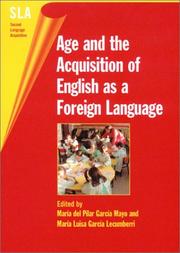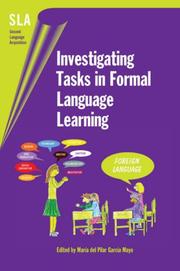| Listing 1 - 4 of 4 |
Sort by
|


ISBN: 1788920384 128082817X 9786610828173 9781853596403 185359640X 9781853596407 1853596396 9781853596391 1853596388 1853596396 9781853596391 9781853596384 9781788920384 Year: 2003 Volume: 4. Publisher: Bristol Blue Ridge Summit
Abstract | Keywords | Export | Availability | Bookmark
 Loading...
Loading...Choose an application
- Reference Manager
- EndNote
- RefWorks (Direct export to RefWorks)
This book provides an overview of current research on the age factor in foreign language learning, addressing issues, which are critical for language planning. It presents new research on foreign language learning within bilingual communities in formal instruction settings focussing on syntax, phonology, writing, oral skills and learning strategies.
Bilingualism in children. --- English language --- Language acquisition --- Language and languages --- Foreign language study --- Language and education --- Language schools --- Age factors in language acquisition --- Ability, Influence of age on --- EFL (Language study) --- English as a foreign language --- English as a second language --- English to speakers of other languages --- ESL (Language study) --- ESOL (Language study) --- Teaching English as a second language --- TEFL (Language study) --- TESL (Language study) --- Children --- Study and teaching --- Foreign speakers. --- Age factors. --- Study and teaching. --- Foreign students --- Langage --- Langage et langues --- Anglais (Langue) --- Bilinguisme chez l'enfant --- Acquisition --- Facteurs liés à l'âge --- Etude et enseignement --- Allophones --- Language and languages Study and teaching --- Interpersonal communication in children --- Psycholinguistics --- Germanic languages --- age and SLA. --- age and foreign language learning. --- age factor in SLA. --- age factor. --- age in second language acquisition. --- language learning. --- second language acquisition.


ISBN: 1853599263 1853599271 9781853599279 9781853599262 185359928X 9781853599286 1280739428 9786610739424 1788920368 9781280739422 6610739420 9781788920360 Year: 2006 Publisher: Bristol Blue Ridge Summit
Abstract | Keywords | Export | Availability | Bookmark
 Loading...
Loading...Choose an application
- Reference Manager
- EndNote
- RefWorks (Direct export to RefWorks)
This book contributes to the growth of interest in task-based language learning and teaching that has been seen in recent years. It brings together research that focuses on various aspects and effects of pedagogic task design and presents work that uses tasks to examine oral interaction, written production, vocabulary and reading, lexical innovation and pragmatics in different formal language learning contexts and in different languages (English as a second/foreign language, French/German/Italian/Spanish as foreign languages). It also provides guidelines for task classification, sequencing and design. The book is addressed to both professionals and students interested in second language acquisition research. It will also be of use to professionals involved in language pedagogy and curriculum design.
Language and languages --- Task analysis in education. --- Study and teaching. --- Analysis, Task (Education) --- Foreign language study --- Education --- Language and education --- Language schools --- Language and languages Study and teaching --- Study and teaching --- SLA. --- Second Language Acquisition. --- classroom. --- curriculum design. --- formal language learning contexts. --- language pedagogy. --- task-based language learning. --- task-based language teaching. --- vocabulary.
Book

ISBN: 128120482X 9786611204822 1847690246 9781847690241 9781847690234 9781847690227 1847690238 184769022X Year: 2007 Publisher: Bristol Blue Ridge Summit
Abstract | Keywords | Export | Availability | Bookmark
 Loading...
Loading...Choose an application
- Reference Manager
- EndNote
- RefWorks (Direct export to RefWorks)
The view that a bilingual speaker, or a speaker acquiring more than one language, is the sum of two —or more— monolinguals is proving to be a myth rather than a reality. Accordingly, this book provides a new profile of children and young people becoming bilingual or multilingual in today’s multicultural Spain. The chapters present studies on the acquisition of the four official languages plus the languages of several new communities. They include descriptive, functional, pragmatic and formal perspectives, covering phonetics, lexis, morphology and syntax, as well as code mixing and input, bilingual twins, SLI bilingualism, narratives, literacy, age and stay abroad effects. The book should be of interest to graduate students and researchers working in the field of second and foreign language acquisition and multilingualism, language planners, language teachers and families alike.
Bilingualism in children --- Multilingualism in children --- Language acquisition. --- Acquisition of language --- Developmental linguistics --- Developmental psycholinguistics --- Language and languages --- Language development in children --- Psycholinguistics, Developmental --- Interpersonal communication in children --- Psycholinguistics --- Children --- Acquisition --- Bilingualism. --- Biliteracy. --- Codemixing. --- Codeswitching. --- Early trilingualism. --- First language acquisition. --- Literacy. --- Monolingualism. --- Multicultural Spain. --- Multilingual language acquisition . --- Multilingualism. --- SLI bilingualism. --- Second language acquisition. --- Spain. --- Young multilinguals.
Book

ISBN: 9781847691668 1847691668 9781847691651 184769165X 1847699006 9786612135866 1282135864 1847691676 9781847691675 Year: 2009 Volume: 41 Publisher: Bristol Blue Ridge Summit
Abstract | Keywords | Export | Availability | Bookmark
 Loading...
Loading...Choose an application
- Reference Manager
- EndNote
- RefWorks (Direct export to RefWorks)
This book contributes to the growth of interest in Content and Language Integrated Learning (CLIL), an approach to second/foreign language learning that requires the use of the target language to learn content. Within the framework of European strategies to promote multilingualism, CLIL has begun to be used extensively in a variety of language learning contexts, and at different educational systems and language programmes. This book brings together critical analyses on theoretical and implementation issues of Content and Language Integrated Learning, and empirical studies on the effectiveness of this type of instruction on learners’ language competence. The basic theoretical assumption behind this book is that through successful use of the language to learn content, learners will develop their language proficiency more effectively while they learn the academic content specified in the curricula.
Language and languages --- Language arts --- Study and teaching --- Correlation with content subjects --- Schoolbooks - Didactic material --- Communication arts --- Communication --- Language and languages - Study and teaching - Europe --- Language arts - Correlation with content subjects - Europe --- CLIL. --- Content and Language Integrated Learning. --- SLA. --- empirical studies on CLIL. --- empirical studies on SLA. --- foreign language learning. --- multilingualism. --- research on CLIL. --- second language learning.
| Listing 1 - 4 of 4 |
Sort by
|

 Search
Search Feedback
Feedback About UniCat
About UniCat  Help
Help News
News